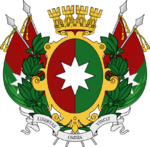Miskism
| Part of a series on |
| Miskism |
|---|
| Religion in Esquarium |
| Beliefs |
| Tradition and practice |
| See also |
Miskism (Aucurian: miškybė) is the traditional ethnic religion of the Aucurian people. Polytheistic and animistic, Miskism focuses upon a diverse cast of gods and spirits, the ties between the physical and spiritual worlds, and upon human moral obligations to uphold the harmony of reality, known as darna, in their pursuit of the asmatikslai. It is sometimes called the "Aucurian national religion", though it holds no official status.
References to certain Miskist rituals and figures appear in Neo-Sepcan and Tastanist texts as far back as the 5th century CE; however, the recording of Miskist myths by practicioners of the religion cannot be traced back farther than the 8th century, and the codification of Miskist practices and rituals seems to begin in the 11th century, alongside the rise of the Kingdom of Aucuria. Miskist theology, philosophy, and mysticism flowered during the High Middle Ages. Efforts at conversion by Tastanist and Cositene polities and missionaries proved largely unsuccessful, though Tastano-Cositene notions such as zakon did influence Miskist thought.
Following a period of comparative stagnation, mirrored by the Torpor in continental West Borea, Miskism experienced a revival beginning in the 16th and 17th centuries, being influenced by syncarist ideals such as humanism and rationalism. Though the Aucurian Revolution resulted in the secularization of Aucurian governance, guarantees of freedom of religion in the Declaration of the Rights of the People and Constitution of Aucuria allowed the religion to continue to operate broadly and openly in the public sphere. The religion has continued to thrive into the present.
Miskism has traditionally been a major part of Aucurian culture, playing an important role in Aucurian literature, poetry, music, and philosophy, and remains the largest religion in Aucuria today. The religion also has strong monastic and mystical traditions. It has historically been influenced by Tastanism, Costeny, Saturnism, and Kelemism.
While philosophical schools known as paražai and associations of Miskist shrines and temples exist, Miskism lacks a centralized religious authority, and different individuals and groups place emphasis upon different theological concepts, scriptures, and holy figures. It is estimated that roughly nine million people are Miskists.
Etymology
Miskism is known by a variety of vernacular names within Aucuria, including senovės takas ("the ancient path"), amžinas takas ("the eternal path"), dievu takas ("the path of the gods"), darnos takas ("the path of darna"), girios takas ("the path of the wilderness"), and miško takas ("the path of the forest"). It is from the lattermost of these that the Aucurian miškybė, and thence the French miskisme, are derived.
Though the religion is now referred to officially as miškybė within Aucuria, the term itself appears to have been a comparatively late development, and is not attested before the 16th century. Some linguists have proposed that it was created in imitation of the names of foreign religions such as Tastanism, Costeny, and Saturnism (tastanybė, kostenybė, and saturnybė in Aucurian).
Beliefs
Darna
Darna (literally "harmony") is a concept of central importance in Miskism, though the exact weight placed upon it varies between paražai. Darna encompasses a variety of notions including law, morality, piety, justice, righteousness, and individual merit. Silvestras Eivydas, in his book Miskism and Kelemism: Their Histories and Interactions, stated that:
Darna, depending on the context of its usage, can mean obedience to law (either man-made or natural), duty, and custom or tradition; it can mean religious devotion, and acting in a virtuous or pious fashion; it can mean showing any number of values, ranging from charity and kindness, to diligence, justice and honor and righteousness; or it can be used to mean personal character or merit. It can be used in relation to nature, to the gods, to people, and to their actions or traits. Perhaps the simplest possible definition- and the meaning of the term in common parlance among Miskists- would be that darna is simply the right way of living.
The meaning of the word darna can vary heavily based upon context, and its meanings and implications have changed as Miskist theology and philosophy have developed. In the earliest texts, it refers primarily to a notion of cosmic order or natural law; as time passed, however, it was increasingly and varyingly applied to values, actions, and individuals. As a result of these numerous meanings, darna is either translated differently depending on context, or left untranslated entirely, in foreign-language translations of Miskist texts.
The antonym of darna is nedarna (literally "disharmony" or "cacaphony"). As with darna, the term nedarna includes and implies many ideas, including impiety, immorality, illegality, tyranny, unethicality, and sin.
Miskist sects universally emphasize that individuals have a duty to uphold darna through their thoughts and actions. Actions, behaviors, and traits may be considered either darnic or nedarnic based on their moral character. Individuals who live righteously strengthen darna and, it is typically held, will be rewarded in the afterlife; individuals who live immorally, by contrast, strengthen nedarna and risk suffering for their actions in the afterlife. Some Miskist theologians draw additional distinctions between darna of the body (encompassing deeds, actions, and behaviors), darna of the mind (encompassing thoughts and beliefs), and darna of the world (encompassing notions of natural law and cosmic order), further sub-categorizing actions within these categories as either darnic or nedarnic.
It is also typically agreed that there is a relationship between darna and the Miskist pantheon, though the exact nature of this relationship varies between paražai. Members of the Atsvertybė paražas maintain that deities and spirits are simply manifestations of darna or nedarna, with darna as the underlying principle of both reality and Miskism; by contrast, members of the Pasaktybė paražas argue that darna is created and maintained by the gods, rather than vice-versa, and that darna should be sustained through righteous deeds and participating in rituals expressing devotion to the gods, rather than through direct veneration of darna itself.
Darna is often compared to the Khaturvist notion of dharma (with which it shares an etymological root) and the Tastano-Cositene notion of zakon, which heavily influenced it.
Asmatikslai
The asmatikslai (sing. asmatikslas) are the proper aims of a human life in Miskism. In Miskism, each human is held to have one or more true asmatikslai; pursuing one's true asmatikslas, it is held, will both strengthen darna and provide the individual with temporal happiness and spiritual fulfillment. It is often compared with the Kamist notion of true wills, with which it shares several major similarities.
Different Miskist sects have different lists of asmatikslai...
Deities
Miskism is a polytheistic religion, believing in a wide variety of gods and goddesses. These deities are involved in all aspects of nature and humanity. Some deities held dominions over aspects of nature or natural phenomena; other deities were regarded as the patrons of certain concepts; others were accorded patronage over areas of human society; still others were regarded as patrons of the spirit world. There is a distinct hierarchy of deities in Miskism, with the two most prominent deities being Ašvienas, god of the sun, and Jievarė, goddess of the earth and of agriculture, though neither are considered to be almighty. All significant deities were visualized as human in form, although they were often able to transform themselves into animals or natural phenomena as desired.
While they are held to be immortal, Miskism does not regard its deities as omnipotent, omniscient, or omnibenevolent. Miskist deities are typically accorded human personality traits, including both virtues and vices. They are typically held to be immanent, possessing physical forms and being able to directly interact with people if they so choose.
[more detail about which deities are the most important, their personalities, and their relationships]
Spirits
In addition to the major gods and goddesses, Miskists recognize a variety of lesser divinities commonly referred to as spirits. The character, nature, and power of these spirits vary wildly; some are regarded as benign, others as beneficial, others as malicious; some reside solely in the spiritual world, while others pass into the material world; some are associated with geographical features or natural phenomena, whereas others are not.
[go over prominent types of spirit and major spirits, most infamously braukstas]
Saints
[this is what happens to pious humans; they're not deified outright but they are venerated]
[tie in to similar kelemist notions]
Tikrovas
Eschatology
Scriptures

Main traditions
Paražai
Miskism has seven paražai (sing. paražas; "tradition"), of which five are considered "orthodox traditions" (stačiatikiu paražai) and two are considered "heterodox traditions" (nestačiatikiu paražai).
Orthodox paražai
Heterodox paražai
Folk Miskism
Practices
Ethics
Worship
Public worship

Private worship

Religious sites

Clergy
Holidays
Seasonal celebrations
Other holidays
Life-cycle events
tbd coming of age ritual
Marriage
Death and mourning
History
Before 1025





